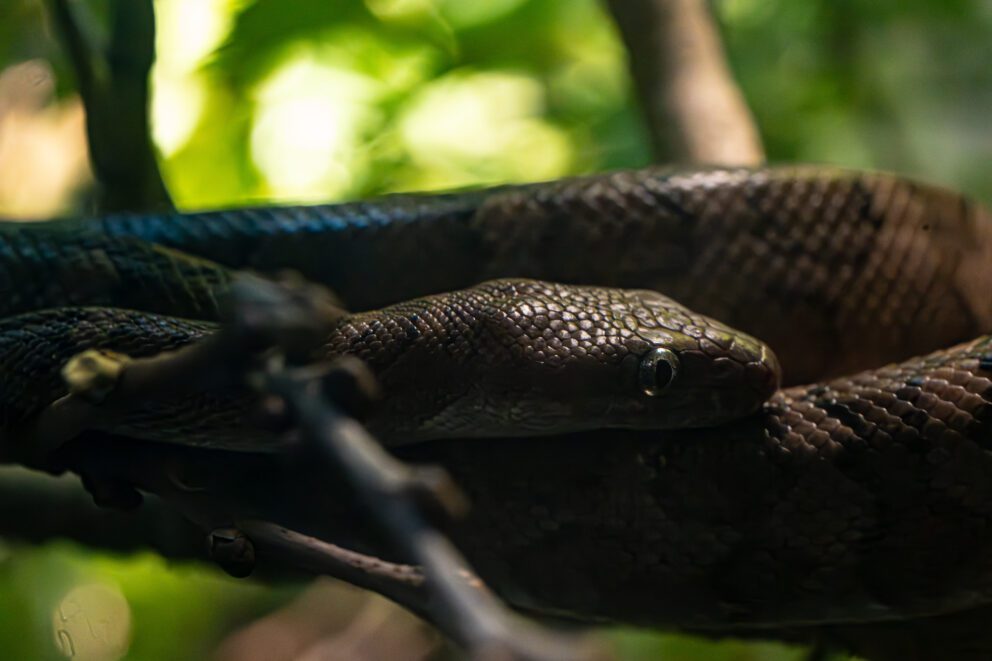With Zoo Ball: The Serpentine Soiree coming soon, we’re sweet on snakes! Lincoln Park Zoo is home to a number of snake species, including the West African Gaboon viper, the Aruba Island rattlesnake, the eastern massasauga rattlesnake, the African rock python, the green tree python, the Kenya sand boa, the royal ball python, and the Virgin Islands boa.
Each species is charming in its own way. Don’t think so? We get it. But here are a few myths about snakes we’d love to dispel, so you can better appreciate how interesting and important snakes truly are.

Aruba Island rattlesnake image and green tree python cover image courtesy of Bryan Summerford;
Myth #1: Snakes are slimy and cold.
People who have touched a snake generally describe them as dry and soft—smooth and slightly cool to the touch. You can sometimes feel their musculature under the skin, which is especially apparent when they are moving.
Myth #2: Snakes unhinge their jaws to eat.
Some snakes have been known to eat surprisingly large prey animals, but they cannot swallow animals that won’t fit past their jaws. However, they have an adaptation called a “gape” that allows them to increase the width of their jaw. The lower bones of the jaw or mandible are not connected. At the front, the jaw is attached with a ligament that stretches. At the back, the mandibles on each side, upper and lower, are loosely connected and can move independently of one another.
So, there’s no actual “dislocation” of the jaw going on, as some may believe. A snake uses a side-by-side motion to slowly move an animal it has caught into its body and then chemically digests the food. Pit vipers like the West African Gaboon viper inject venom into their prey’s body, which liquifies their insides, thus aiding digestion. This is important because snakes are vulnerable while they are eating.

Virgin Islands boa
Myth #3: Many snakes are poisonous.
Here’s where we get into some definitions: Poisonous animals are toxic when touched, ingested, or inhaled. Venomous animals, meanwhile, inject toxins into another animal through a bite or sting.
A fair number of snake species are indeed venomous, like rattlesnakes, copperheads, cottonmouths, and coral snakes. A few species are also poisonous, often because animals they eat (think frogs) have toxins that transfer.
Myth #4: Snakes are aggressive and dangerous.
There are more than 4,000 snake species, and around 600 of these are venomous. Of the venomous snakes, around 200 have toxins strong enough to hurt humans. But most snake species are not typically aggressive; they act only in defense. That’s at least in part because not all snakes are apex predators. Most are mesopredators, which means they have a position right in the middle of the food web. As they are also prey animals to raptors and other carnivores, they must be able to protect themselves. Most of these reptiles would prefer to hide and avoid confrontation, unless they are provoked.
Observe, Don’t Disturb
Snakes don’t chase people or size them up as prey. Leave them alone and they’re likely to leave you alone!
Myth #5: You can identify how dangerous a snake is based on their coloration or the shape of their head.
Some people believe you can tell if a snake is venomous by the triangular shape of its head or the bright coloration of its body. This is not a dependable way of identifying snakes that may be dangerous, so be cautious!
Snakes have many different adaptations which affect the way they look. These adaptations help them survive in specific habitats and will not necessarily have the same function in different species. Snakes may also change color throughout their life, so identification may not be as easy as you think.
An example of this misconception is the common krait, a South Asian snake. It is characterized by a black or bluish-black body with white crossbands—and it has an unmistakably rounded head. This snake is known for its potent venom and is considered one of the “Big Four,” the top venomous snake species on the Indian subcontinent responsible for the most deaths each year.

African rock python image courtesy of Keeper Bryan Summerford
Myth #6: Snakes have no bones.
It’s tempting to think this, considering how flexible and slithery they are. Actually, snakes have a rather sophisticated skeleton, as evidenced by the snake’s ability to take in such large prey. And they have up to 400 bones—more than humans, in fact. Most of these bones are vertebrae and ribs; snakes have a very long spine that goes almost the entire length of their body.
Myth #7: Snakes can blink (or wink).
In Harry Potter and the Sorcerer’s Stone, a snake winks at young Harry when he visits the zoo with his uncle, aunt, and cousin Dudley. Sadly, that kind of thing only happens in the Wizarding World because snakes do not have eyelids. They do have an “eye cap” for protection of their eye. This eye cap, or spectacle, is shed periodically along with the skin and you can see it as part of the removed shed.
Snake Senses
Snakes do not have an external ear, but they do have the same inner ear parts as humans. Their stapes, which transmit sounds, connect to the jawbone to allow them to sense vibrations. As for their sense of smell: they catch scents with their tongues. An organ on the roof of their mouth, called the Jacobson’s organ, detects chemicals provided by a snake’s tongue (which is forked and thus has more surface area to capture scent particles). If you see a snake flicking its tongue, it’s simply working to make sense of its environment.
Myth #8: Snakes don’t take care of their offspring.
In fact, some snake species can be very good parents, whether they are viviparous (giving live birth with a placenta, like mammals) ovoviviparous (when eggs hatch inside the mother before birth), or oviparous (about 70% of snakes are egg-layers). Certain species protect and care for their young both before and after they come into the world.
The South African python, for example, coils around eggs in her den to keep them warm until they hatch. Then, the mother python will continue to provide heat to her 40–50 young for several days until they can bask on their own. She stays with the nest for up to three weeks after their hatching, even though not hunting or eating during the breeding season means she loses up to 40% of her body weight. Some python moms even starve after bearing children.

West Gaboon viper image courtesy of Keeper Bryan Summerford
Myth #9: The only good snake is a dead snake.
Negative perceptions of snakes have been around since the beginning of history. People fear them—or more accurately, they often fear the stereotypes and misconceptions associated with snakes. There’s even a word for the fear of snakes: ophidiophobia. It’s one of the most common phobias of animals. This has led to the untimely death of many snakes.
However, snakes are a critical part of controlling pest populations (and the diseases that pests spread) from insects and rats to frogs. In fact, timber rattlesnakes, which eat small mammals in places like forests in the eastern U.S., have directly benefited human health. Research indicates that each snake removes up to 4,500 ticks annually in these areas, as they hunt the small mammals that ticks gravitate to. This makes it much less likely that those ticks will spread Lyme disease to people.
Snakes are also an important part of the food web, as they are both predator and prey. Carnivores like foxes, birds of prey, and even other snakes will eat snakes. They are an indicator species, as their decline in an area may signify worsening ecosystem health. And they are secondary seed dispersers—when snakes consume rodents that eat seeds, they help spread seeds around the environment through their excretions.

African rock pythons, image courtesy of Keeper Bryan Summerford
As an animal that contributes to biodiversity around the world, snakes are valuable. Many even provide sources of medicine, just like Ozempic is the result of the discovery of a hormone-like molecule found in Gila monster venom. Drugs derived from snake venom include captopril, which comes from the Jararaca pit viper and treats high blood pressure; cobratide, which is extracted from the Chinese cobra and acts as an analgesic that relieves chronic pain; batroxobin, which comes from the Bothrops atrox pit viper and is used to break up blood clots, and eptifibatide, which is derived from a peptide in the venom of the southeastern pygmy rattlesnake and acts as an anticoagulant that reduces the risk of heart attacks.
In other words, the misconceptions surrounding snakes are robbing us of important resources as well as some fascinating animals. If you’re ready to give some appreciation to these reptiles now, come to Lincoln Park Zoo! Several snake species are located at Regenstein Small Mammal-Reptile House. And if you’re lucky, you may even spot some wild snakes at Nature Boardwalk.







